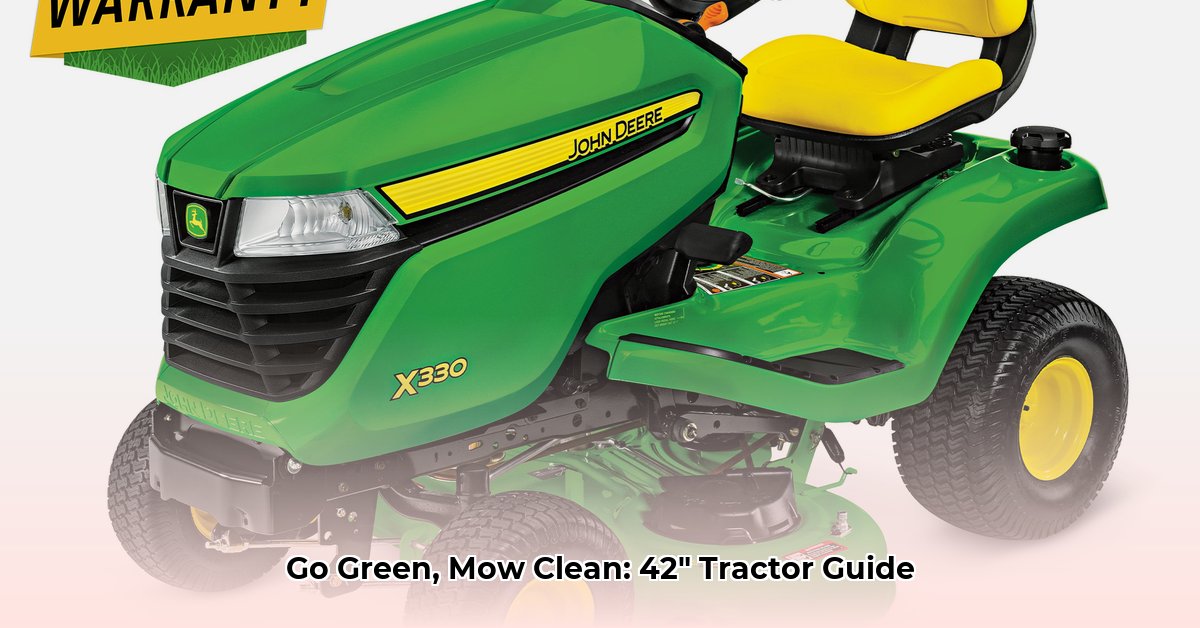
Let's talk lawn care. A large lawn often necessitates a powerful mower, and a 42-inch lawn tractor is a popular choice. While a larger cutting deck means faster mowing, it's crucial to consider the environmental impact. This guide helps you weigh the pros and cons of 42-inch mowers, focusing on sustainability and providing practical advice for eco-conscious lawn maintenance. For more details on specific models, check out this helpful resource on Husqvarna 42-inch mowers.
The Big Question: Speed vs. Sustainability
A 42-inch cut significantly reduces mowing time. But this speed comes at a cost: larger engines consume more fuel and produce more emissions. This presents a key dilemma: prioritize speed and convenience, or minimize your environmental footprint? The decision rests on a careful evaluation of individual needs and priorities.
Pros and Cons of a 42-Inch Riding Mower
This table summarizes the advantages and disadvantages:
| Feature | Advantages | Disadvantages |
|---|---|---|
| Mowing Speed & Efficiency | Significantly faster mowing for larger lawns; reduces physical exertion. | Higher fuel consumption; increased greenhouse gas emissions. |
| Maneuverability | Suitable for open spaces; generally easy to operate. | Can be less maneuverable in tight spaces; requires a wider turning radius. |
| Cost | Higher initial purchase price; potentially higher maintenance costs. | Long-term savings may offset initial cost if time saved is a significant factor. |
| Environmental Impact | Fewer passes can slightly mitigate fuel use (depends on lawn size). | Contributes significantly to greenhouse gas emissions; reliant on fossil fuels. |
Making Smart Choices: Sustainable Mowing Tips
Here's how to approach buying a 42-inch tractor (or any mower) sustainably:
Honest Yard Assessment: A smaller mower, or even a robotic mower, might be more appropriate for smaller lawns, saving money and reducing environmental impact. Is a 42-inch deck truly necessary for your specific needs?
Fuel Efficiency Check: If choosing a gas-powered mower, compare fuel efficiency ratings (often provided by the EPA) to minimize fuel consumption. How can you maximize the efficiency of the engine you select?
Explore Alternative Power Sources: Electric or hybrid lawn tractors are gaining popularity. While the upfront cost may be higher, long-term savings on fuel, coupled with reduced emissions, offer significant environmental benefits.
Mowing Smarts: Mow less frequently. Allowing grass to grow slightly longer reduces water needs. Consider using mulching blades to recycle grass clippings as natural fertilizer, reducing the need for chemical fertilizers and increasing overall sustainability. Keep your mower blades sharp - this improves cutting efficiency and reduces engine strain.
Think Long-Term Costs: Factor in fuel costs, maintenance, repairs, and potential replacement costs when comparing models. A more expensive, fuel-efficient model might be a better long-term investment.
The Future is Greener
Electric and hybrid lawn tractors are becoming more affordable and efficient. Advances in battery technology extend runtimes and reduce charging times, while manufacturers continually strive to improve engine efficiency and reduce emissions. The industry is shifting towards more environmentally responsible options.
How to Choose a Fuel-Efficient 42-Inch Riding Lawn Mower
Key Takeaways:
- Fuel efficiency depends on engine type, transmission, and overall design.
- Engine size should match lawn size and terrain; larger isn't always better.
- Hydrostatic transmissions often offer better fuel economy than other types.
- Regular maintenance is crucial for maximizing fuel efficiency and longevity.
- Mulching kits reduce fuel use by eliminating bagging.
Understanding Your Needs
Before purchasing, assess your lawn's size, terrain, and obstacles. These factors influence your engine and transmission choices. A larger lawn necessitates more power, but increased power leads to higher fuel consumption. Hilly terrain requires more power, potentially offsetting fuel efficiency gains. Careful consideration of these factors is paramount.
Engine Power: The Heart of the Matter
Engine power (HP) impacts cutting power and fuel consumption. While higher HP delivers more power, it also increases fuel consumption. For 42-inch mowers, 18-20 HP is often sufficient. However, focus on engine technology; fuel-injected engines or models with advanced air filtration systems typically offer better fuel efficiency.
Transmission: Smooth Sailing or Manual Labor?
Hydrostatic transmissions (HST) provide smooth speed and direction changes, improving maneuverability and potentially fuel efficiency by preventing unnecessary engine revving. Automatic and manual transmissions, while simpler, might be less fuel-efficient.
Cutting Deck Design: The Sharpest Cut
Sharp blades are essential for efficient cutting. Dull blades force the engine to work harder, increasing fuel consumption. Mulching kits effectively recycle grass clippings, reducing the need for bagging, saving time and fuel.
Choosing the Right Machine: A Step-by-Step Guide
- Assess your lawn: Determine size, terrain, and obstacles.
- Research engine options: Prioritize fuel-injected engines or advanced filtration systems.
- Choose a transmission: Hydrostatic transmissions often offer better control and fuel efficiency.
- Consider features: A mulching kit can save fuel.
- Read reviews: Check user reviews for real-world performance data.
Maintenance Matters: Keeping Your Engine Happy
Regular oil changes, air filter replacements, blade sharpening, and proper storage maximize fuel efficiency and extend mower lifespan. Consistent maintenance is a crucial aspect of sustainable lawn care practices.